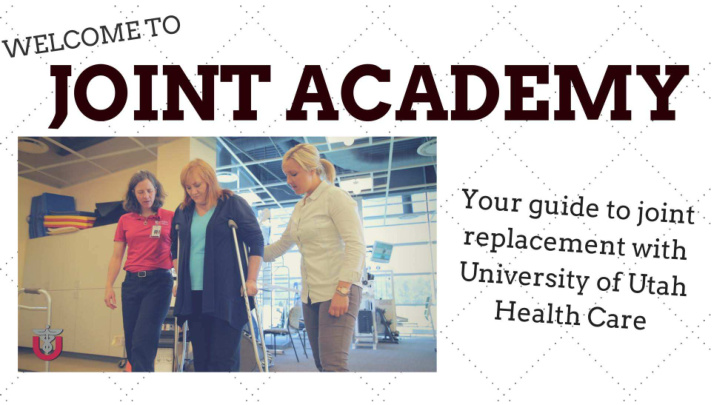



Preparing for surgery The healthier and stronger you are before surgery – the better Dental work: Make sure all dental appointments are completed 6 weeks before surgery– or 12 weeks AFTER. Nicotine: Stop all at least 4 weeks before surgery (includes gum, patches etc. surgery will be cancelled if not) Minimize narcotic use
One Week Before Surgery Stop taking any NSAIDS and start hydrating Stay healthy and don’t get hurt – no wounds/rashes The phone calls begin…
The Day Before Surgery Hydrate Use the body wash night before/morning of (given in clinic) You will be notified for time of arrival between 2 and 5 pm.
Your Surgery & Hospital Stay Meet with anesthesiologist 1 night hospital stay Possible same day discharge if you are lucky
Incision care Your dressing is meant to stay on for two weeks Before a shower, make sure it has a good seal, you can cover with plastic wrap for extra protection against water getting inside NO BATHS, HOT TUBS or POOLS UNTIL INCISION IS COMPLETELY HEALED and scab free. Can be 4-6 weeks post-op
1 expected 3 come for a dressing change 2 OK if…
WHAT IS NORMAL? Warmth , redness, di on , and sw discol scolor orati tion swelling Pain/bruising/hypersensitivity at the tourniquet site (upper thigh area on knee replacements only) Noise from the joint – yes, it can squeak, pop or grind –all normal Takes time for the pain to go away Increase activity while decreasing narcotics (increasing activity that causes your need to increase narcotics means you should ease off your activity a bit)
Medication Management Take your medication in THIS ORDER to manage pain most effectively: TYLENOL – 975-1000 mgs THREE (3) TIMES DAILY – DO NOT exceed 3000 mgs in a 24 hour period NSAIDs – take the prescribed medication – Celebrex/Meloxicam/naproxen – WITH FOOD TRAMADOL – 1-2 tablets EVERY SIX (6) HOURS. Start with one, if your pain is not managed, then take an additional tablet. If 6 hours has passed, and your pain is still under control, then wait a little longer, reassess every 30 minutes if necessary. NARCOTICS – Take sparingly. If the above method is not enough to MANAGE your pain, then, add this medication. Ensure you are still icing/elevating and resting as this TREATS the pain instead of masking it. Start with 1 tablet, but remember, 2 Tramadol are as effective (and last longer) than ONE narcotic medication. Taking additional narcotics before therapy is not advised. Pain is a guide for your level of activity, use it to determine how hard you should work. You still need to push yourself but pain is an indication to stop.
What about medication refills? Please plan ahead and contact the clinic BEFORE you run out of medication. On-call physicians will not do medication refills on nights or weekends, please contact the clinic during office hours. Allow 48-72 hours for any medication refill.
When in doubt? Call… Concerns about your incision, pain, nausea We can help. Our goal is to avoid unnecessary Emergency Room visits 801-587-7109 – Business hours (8 am-5 pm) 801-581-2121 – After hours
After Surgery • Up out of bed a few hours after surgery • Work on transfers/walking/stairs/exercises • Practice with and decide on equipment • Walker vs crutches • Toilet riser, shower bench, reacher, sock aide • Prepare for discharge home within 24 hours
Options for after the hospital • Home with self directed exercises • Program emailed – reply with questions • Home with outpatient PT • Make appointment 1 week before surgery • Home with home health • Case management will help with setup
The first two weeks at home • Focus should be on swelling management and mobility – Elevate and ice often through the day – Walk several times a day inside the house – Progress to one crutch/cane to nothing when no limp and no pain when walking – Don’t overdo exercise
2 week follow up • Visit with PA in clinic – Goals are 5-90 degrees flexion, good quad contraction, no limp with or without a device – Progress exercises and mobility • Continue or start outpatient PT • Continue with self directed exercises – Next stage of exercises printed/emailed
6 week follow up • Visit with MD in clinic – Goals are for 0-120 degrees flexion, good strength in quads, hamstrings, calf and no limp – Progress exercises and mobility • Continue outpatient PT progressing to independent exercise/activity • Work towards an activity based program vs exercise based
Pain Management Pain: A Psychological Perspective .
Pain Behavior Suffering Pain Nocioception
Pain Behavior Suffering Pain Nocioception
Pain Behavior Suffering Pain Nocioception
Pain Behavior Suffering Pain Nocioception
Pain Behavior Suffering Pain Nocioception
“Pain is inevitable; suffering is optional. The arrow of pain does not need to be followed by the arrow of suffering.” Pain Behavior Suffering Pain Nocioception
Exercise
Pain, Thoughts and Emotions
A Situation B C Consequences: Beliefs & Feelings & Behavior Thoughts
Pain Nocioception B C Pain Behavior Suffering Consequences: Beliefs & Feelings & Behavior Thoughts
Questions?
Recommend
More recommend